Ijraset Journal For Research in Applied Science and Engineering Technology
- Home / Ijraset
- On This Page
- Abstract
- Introduction
- Conclusion
- Copyright
Email Management Platform
Authors: Abhinav Kachole, Aniket Nagpure, Atharva Wagh, Prof. T. H. Patil
DOI Link: https://doi.org/10.22214/ijraset.2024.56840
Certificate: View Certificate
Abstract
This research project endeavors to enhance the email experience for users across the globe. The overarching goal is to create an innovative email platform that accommodates speakers of any language. The project aims to simplify email management, facilitate text translation across languages, incorporate text-to-speech and speech-to-text functionalities, bolster security against threats and malware, automate mail classification and grouping, and implement advanced spam filtering. The study explores the synergy of various technologies to improve the user interface and overall functionality, contributing valuable insights to the discourse on the intersection of technology and global connectivity. This research not only seeks to make emails more efficient but also aims to play a role in shaping a more user-centric and inclusive digital communication landscape. In the course of this research, the focus extends beyond the technical aspects to delve into the ways in which individuals from diverse backgrounds engage with email. By understanding the unique needs and preferences of users worldwide, the project aims to create an email platform that transcends linguistic and cultural barriers. This research contributes not only to the refinement of email technology but also to the broader conversation about the societal impact of technology in fostering global connections. The study promises an enlightening exploration into the future of email and its potential to foster a more connected and harmonious digital world.
Introduction
I. INTRODUCTION
In an era marked by unprecedented global connectivity, communication stands as the linchpin of societal and professional interactions. As the world becomes increasingly interconnected, the need for a versatile email platform that transcends linguistic barriers becomes imperative.
This research embarks on the ambitious journey of conceiving and developing an email platform that is not only adept at managing communications but is also tailored to cater to users across a spectrum of spoken languages.
Traditional email platforms, while serving as indispensable tools for communication, often fall short in accommodating the linguistic pluralism inherent in today's interconnected world. Users grappling with language discrepancies may encounter barriers to efficient communication, hindering the potential of email as a global communication medium. This project seeks to bridge this gap by introducing a novel email platform that not only facilitates the efficient management of emails but also champions a multilingual approach, promoting inclusivity and breaking down language barriers.
In the perpetual battle against unwanted and potentially harmful emails, the email platform incorporates a sophisticated spam identification and filtering mechanism. A combination of rule-based filters and machine learning algorithms works in tandem to accurately identify and divert spam emails away from users' primary inboxes.
The rule-based filters leverage predefined criteria to flag emails exhibiting common characteristics of spam, while the machine learning algorithms continuously adapt to evolving spam patterns. Regular updates to the spam filters ensure that the platform remains adept at recognizing and mitigating emerging spam tactics. Users are provided with the flexibility to customize and fine-tune spam filters, allowing them to tailor the level of sensitivity to their preferences.
Efficient organization and categorization of emails contribute significantly to a streamlined user experience. The email platform employs advanced machine learning algorithms to automatically classify and group incoming emails based on user behaviour and predefined criteria. Through continuous analysis of user interactions with the platform, the system learns to discern patterns and intelligently categorize emails into distinct folders.
II. LITERATURE SURVEY
Email communication, a cornerstone of modern interaction, continues to evolve in response to the dynamic challenges posed by cyber threats and linguistic diversity. This literature review delves into recent research focusing on innovative algorithms and multilingual support, exploring how these advancements contribute to the development of secure, efficient, and user-friendly email platforms.
A. Machine Learning Algorithms for Spam Filtering
Early studies have extensively explored the application of machine learning algorithms, with a particular focus on the k-Nearest Neighbours (k-NN) algorithm in spam filtering. However, concerns about scalability and processing speed have led researchers to seek alternative algorithms that offer faster classification without compromising accuracy. The exploration of hybrid approaches, combining the strengths of various algorithms, emerges as a promising avenue for achieving more robust spam detection systems.
B. Random Forest for Spam Filtering
Recent literature emphasizes the superiority of the Random Forest algorithm in spam email filtration. Renowned for its high classification accuracy, Random Forest employs an ensemble learning approach, aggregating multiple decision trees. This technique proves effective in distinguishing between spam and non-spam emails, showcasing promise in reducing false positives and false negatives. Ongoing research suggests further exploration of ensemble learning methods and their potential for enhancing spam detection accuracy.
C. Boyer Moore Algorithm for Content Filtering
Content filtering, a critical component of cybersecurity, has seen advancements with the Boyer Moore algorithm. Recognized for its efficiency in detecting textual patterns, this algorithm plays a crucial role in rapidly searching and identifying specific content within emails. Researchers advocate for its integration into broader cybersecurity frameworks to bolster the identification and prevention of malware and virus attacks, showcasing the significance of algorithmic innovations in ensuring secure email communication.
D. JSAPI (Java Speech API) for Speech-to-Text and Text-to-Speech
The literature highlights the versatile nature of the Java Speech API (JSAPI) in incorporating speech-to-text (STT) and text-to-speech (TTS) functionalities into applications. This inclusion enables the creation of user interfaces that transcend traditional text-based interactions. While JSAPI presents opportunities for more accessible and interactive communication, ongoing challenges such as dialect variations and speech recognition accuracy prompt researchers to explore advancements in JSAPI and alternative speech API options.
E. Google Cloud Translation API for Language Translation
The Google Cloud Translation API emerges as a powerful solution for language translation services. Beyond its application in multilingual support and global content localization, researchers explore its potential in handling complex linguistic nuances. The evolving nature of language and the need for real-time translation capabilities prompt investigations into the adaptability and scalability of the Google Cloud Translation API across diverse linguistic contexts.
F. Natural Language Processing (NLP) in Spam Detection
An emerging trend in the literature is the application of Natural Language Processing (NLP) techniques in spam detection. NLP allows for a deeper analysis of the textual content of emails, considering linguistic nuances and context. Researchers investigate how sentiment analysis, semantic understanding, and contextual relevance can be leveraged to enhance the accuracy of spam identification, particularly in the face of evolving spamming tactics.
G. Advanced Content Filtering Techniques
Beyond traditional content filtering methods, researchers are actively exploring advanced techniques such as deep content inspection and behaviour-based analysis. Deep content inspection involves scrutinizing the content of emails at a granular level, while behaviour-based analysis assesses the historical patterns of user interactions to identify potential threats. Integrating these advanced techniques is crucial for fortifying email platforms against sophisticated cyber threats.
H. User-Centric Design for Email Platforms
User-centric design principles take centre stage in recent literature, emphasizing the importance of tailoring email platforms to user preferences and behaviours. Intuitive interfaces, customizable features, and user-friendly experiences are highlighted as key elements. Integrating user feedback mechanisms and incorporating accessibility features ensures that the email platform not only meets functional requirements but also aligns with the diverse needs and preferences of its user base.
I. Challenges and Future Directions in Multilingual Communication
Researchers address challenges in multilingual communication within digital platforms. Issues such as accuracy in translation, cultural nuances, and dialect variations pose ongoing challenges. The literature emphasizes the need for continuous advancements in language processing technologies and cross-cultural studies to address these challenges and enhance the effectiveness of multilingual communication features in email platforms.
In conclusion, the literature survey underscores the dynamic and evolving nature of email platform development. From exploring hybrid approaches in spam filtering to harnessing the power of NLP and advanced content filtering techniques, researchers are actively pushing the boundaries of what is possible in creating secure, efficient, and user-friendly email platforms. Future directions suggest a continued exploration of innovative algorithms, increased focus on user-centric design, and addressing the complex challenges associated with multilingual communication in the digital realm.
These advancements collectively contribute to shaping the future landscape of email communication, offering users a more secure, accessible, and personalized experience.
III. AIMS AND OBJECTIVES
A. Efficient Email Access and Management
The primary goal is to create an email platform that optimizes the user experience by providing efficient access and management of emails.
This involves designing a user-friendly interface with intuitive navigation, quick search functionalities, and effective sorting options. The aim is to streamline the process of accessing, organizing, and managing emails, enhancing overall productivity and user satisfaction.
B. Multilingual Support Through Text Translation
This objective centres on breaking language barriers by incorporating robust text translation functionality. The email platform seeks to offer users the ability to seamlessly translate emails between multiple languages.
This feature enhances communication among users who speak different languages, fostering inclusivity and facilitating global collaboration.
C. Text-to-Speech and Speech-to-Text Conversion Support
To cater to diverse user preferences and accessibility needs, the email platform aims to support both text-to-speech and speech-to-text conversion. This functionality empowers users to interact with their emails through spoken language or convert spoken content into written text.
This inclusive approach accommodates users with varying communication preferences and enhances the overall accessibility of the platform.
D. Security Measures Against Threats and Malwares
Ensuring the security and confidentiality of user emails is a paramount objective. The email platform will implement robust security measures to protect against a range of threats and malwares.
sThis includes the integration of encryption protocols, malware detection mechanisms, and antivirus scanning. The goal is to create a secure environment where user data remains confidential and immune to malicious activities.
E. Automatic Mail Classification and Grouping
This objective focuses on enhancing organizational efficiency by implementing automatic mail classification and grouping. The email platform will employ machine learning algorithms to intelligently categorize incoming emails based on user behaviour and predefined criteria. This feature streamlines the organization of emails, simplifying the user's task of managing and locating specific messages.
F. Identification and Filtering of Spam Emails
Addressing the pervasive issue of spam, the email platform aims to automatically identify and filter out spam emails. This involves the implementation of advanced spam detection mechanisms, combining rule-based filters and machine learning algorithms.
By accurately distinguishing between legitimate and spam emails, the platform seeks to minimize the intrusion of unwanted and potentially harmful content, thereby enhancing the overall email experience.
In summary, these objectives collectively contribute to the development of a comprehensive and user-centric email platform. By prioritizing efficiency, multilingual support, accessibility, security, and intelligent organization, the platform aims to redefine the way users interact with their emails, fostering a secure, inclusive, and streamlined communication experience.
IV. METHODOLOGY
A. Login and Authentication Process
- User Verification: The initial step involves verifying user credentials to ensure secure access. Users will be required to enable IMAP (Internet Message Access Protocol) and generate an application-specific password for enhanced security.
- Authentication: The generated application password will serve as a secure authentication token, allowing users to log in securely to the email platform.
B. Mail Fetching Process
- API Integration: Upon successful authentication, the platform will utilize mail APIs to fetch emails from the user's account.
- Database Storage: Fetched emails, along with their metadata, will be stored securely in the platform's database for efficient retrieval and management.
C. Security and Malware Detection
- Virus and Malware Scanning: The platform will implement robust security measures, scanning both the email content and any attached files or documents for viruses and malwares.
- Warning System: If a potentially dangerous file is detected, the system will trigger a warning to alert the user about the potential security threat.
D. Spam Filter
- Content Analysis: The platform will employ a spam filter that analyzes email content for indicators of spam, including advertisements, harmful or vulgar content.
- Marking as Spam: Emails meeting the criteria for spam will be automatically marked, helping users identify and manage unwanted content effectively.
E. Automatic Grouping
- Algorithmic Grouping: The platform will use advanced algorithms to automatically categorize emails based on the sender's email address and the subject of the email.
- User-Defined Sections: The grouped emails will be organized into sections created by the user, enhancing the overall organization and accessibility of their inbox.
F. Dashboard Management
- User Interface Navigation: Users will have access to an intuitive dashboard where they can navigate through the platform's interface effortlessly.
- Action Features: The dashboard will host features that allow users to perform specific actions, such as accessing settings, managing folders, and customizing their email experience.
G. User Actions (Send, Read Mails)
- Mail Interaction: Users can perform actions like reading through received emails, creating drafts for future correspondence, and sending emails to their contacts.
- Draft Management: The platform will provide a user-friendly interface for drafting, editing, and saving emails before sending.
V. ARCHITECTURE
A. Mail Fetching Architecture

The mail fetching architecture comprises a user interface allowing interaction with emails, a mail server for storage, and secure authentication. Utilizing protocols like POP3 or IMAP or SMTP, the system fetches and synchronizes emails, with support for various content types and attachments. Error handling, logging mechanisms, and security measures such as encryption contribute to a reliable and secure email retrieval process. Additionally, the architecture may enable offline access, providing users with seamless and responsive email management across devices. (Diagram 5.1.1)
B. System Architecture
- User Authentication
Component: Authentication Module
Description: When a user attempts to access the email platform, the authentication module verifies the user's credentials. This involves checking the provided username and password against the system records.
2. Mail Fetching
Component: Mail Fetching Module, Mail API
Description: Once authenticated, the system utilizes the Mail Fetching Module, which interacts with the Mail API. The API allows the platform to retrieve emails from the user's account, including metadata such as sender information, timestamps, and email content.
3. Security and Malware Detection
Component: Security Module, Malware Detection Module
Description: Fetched emails, along with any attached files or documents, undergo a security check. The Security Module includes mechanisms for virus and malware detection. If a potential threat is identified, a warning is triggered to alert the user.
4. Spam Filter
Component: Spam Filtering Module
Description: The Spam Filtering Module analyzes email content to identify spam indicators, such as advertisements, harmful, or vulgar content. If an email meets the criteria for spam, it is automatically marked as such.
5. Automatic Grouping
Component: Grouping Algorithm, User-Defined Sections
Description: The platform employs an algorithmic approach to automatically categorize emails. This process is based on the sender's email address and the subject of the email. Grouped emails are organized into sections created by the user, enhancing the overall organization of the inbox.
6. Dashboard Management
Component: User Interface, Dashboard Management Module
Description: The user interacts with the platform through a user-friendly dashboard. The Dashboard Management Module oversees the navigation and provides access to specific features, such as settings, folder management, and customization options.
7. User Actions (Read, Send Mails)
Component: Mail Interaction Module
Description: Users can perform various actions within the platform, such as reading received emails, creating drafts, and sending emails to contacts. The Mail Interaction Module facilitates these user actions, ensuring a smooth and intuitive experience.
8. End of Process
Component: End Module
Description: The process concludes at the "Stop" node. At this stage, the user has successfully interacted with the email platform, and the system awaits further user input or actions.
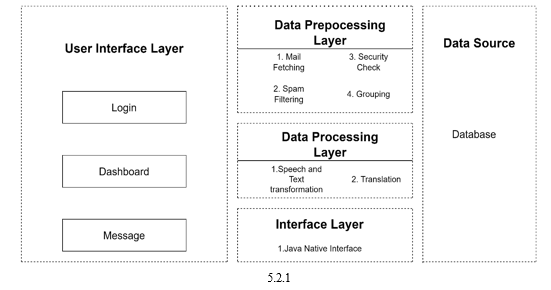
C. System Components And Modules
The architecture follows a modular design, with distinct components responsible for specific functionalities. Modules interact seamlessly, ensuring a cohesive flow from user authentication to email management actions.
The user interface serves as a central point for user interaction, providing a visually intuitive and accessible dashboard. Security measures are embedded throughout the architecture, safeguarding user data and content from potential threats. This architecture promotes a secure, efficient, and user-centric email platform, emphasizing seamless interaction and effective management of email-related tasks.
- Frontend
a. Login and Dashboard: This component enables user to interact with mail platform and perform changes.
b. Message: This will enable user to write and edit mails and messages
2. Backend
a. Fetching: This is used for fetching mails from our mail server to our application using IMAP.
b. Grouping: Labels and keywords are used for grouping mails in one separate block for specific mails.
c. Security Module: This is used for flagging malicious or suspicious text in messages.
d. Translation: Used for translating any text in other languages.
e. Text to Speech: This component is used for converting text into audio speech.
f. Speech to Text: This is used for sending text by giving audio input.
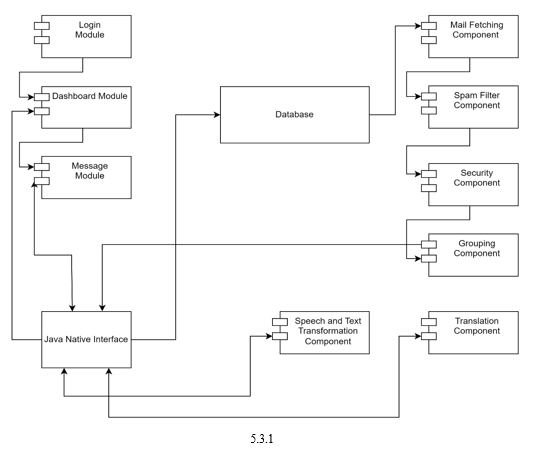
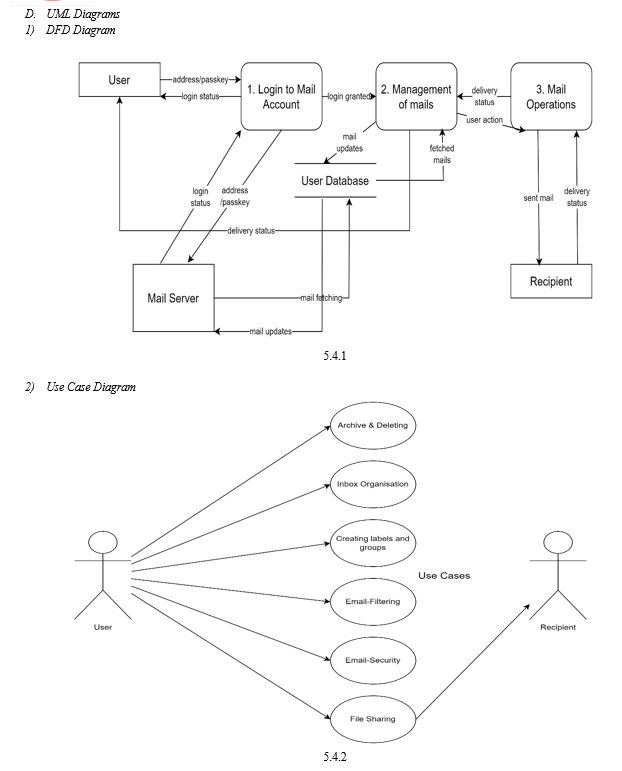
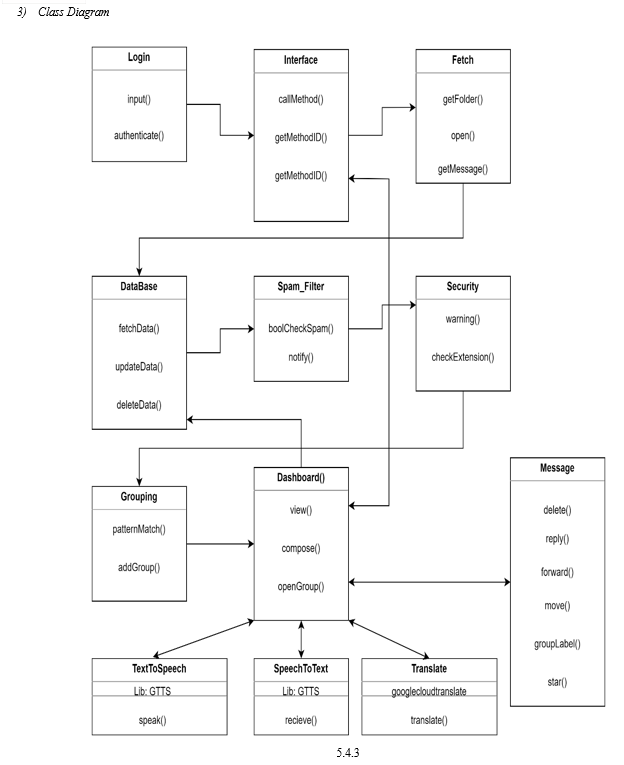
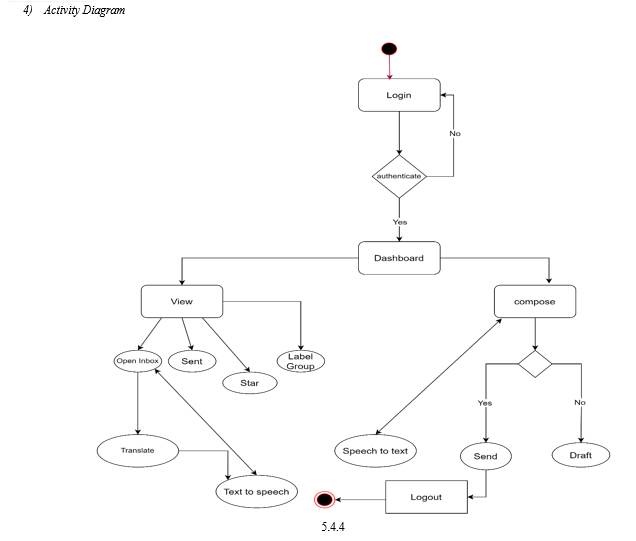
E. Algorithms
- Boyer Moore Algorithm
The Boyer-Moore algorithm is a widely used string searching algorithm that efficiently finds occurrences of a pattern (substring) within a text (string).The primary goal of the Boyer-Moore algorithm is to reduce the number of character comparisons required during the search, making it one of the fastest string searching algorithms.
Key features of the Boyer-Moore algorithm include:
a. Bad Character Heuristic: The algorithm starts comparing characters from right to left (from the end of the pattern to the beginning) and uses a "bad character" heuristic. It calculates how far to skip in the text when a mismatch occurs based on the last occurrence (if any) of the mismatched character in the pattern. This heuristic allows the algorithm to skip over many characters in the text.
b. Preprocessing: The Boyer-Moore algorithm preprocesses the pattern to create lookup tables (e.g., bad character table and good suffix table) that store information about the pattern. These tables allow the algorithm to make quick decisions during the search phase. The main advantage of the Boyer-Moore algorithm is its ability to skip large portions of the text when searching for a pattern, which makes it highly efficient in practice.
2. Content Filtering
Content filtering is a process involving the use of software or hardware to screen and/or restrict access to objectionable email, webpages, executables and other suspicious items.
Content filtering works by identifying content patterns like objects within images or text strings that indicate undesirable content that must be restricted or screened out. Enterprise networks incorporate content filters in various ways. Network administrators can configure firewalls, mail servers, routers and domain name system (DNS) servers to filter unwanted or malicious content.
3. Random forest Algorithm for Spam Filter
Random Forest is a classifier that contains a number of decision trees on various subsets of the given dataset and takes the average to improve the predictive accuracy of that dataset." Instead of relying on one decision tree, the random forest takes the prediction from each tree and based on the majority votes of predictions, and it predicts the final output.
Why choose Random Forest over other approaches:-
When compared to other machine learning approaches, random forests offer numerous advantages, including lower classification errors and higher f-scores. Additionally, its performance is typically comparable to or better than that of SVM. It is capable of handling imbalanced data sets with missing values effectively.
In terms of accuracy, Random Forest outperforms the majority of existing machine learning methods. It performs admirably on big datasets. It is capable of processing hundreds of thousands of input variables efficiently. RFs have the capacity to handle unlabelled data well, making them an excellent approach for grouping unlabelled data. The random forest algorithm is straightforward and requires fewer parameters in comparison to the amount of data.
VI. RESULT
At its core, the platform stands as a testament to inclusivity, breaking down linguistic barriers with robust multilingual support. Through the implementation of text-to-speech transformations, users can effortlessly engage with their emails audibly, accommodating a diverse range of communication preferences. The customizable functionalities of the platform empower users to personalize their email management experience by assigning labels, creating mail groups, and adapting the interface to their unique workflows. Security is a paramount focus, with the platform incorporating advanced measures such as malware detection and spam filtering, ensuring the utmost protection of user data and communication integrity. The introduction of autonomous mail sorting, facilitated by sophisticated algorithms, streamlines the organization of emails, reducing manual efforts and saving valuable time. The user interface is designed for intuitive navigation, providing a user-friendly dashboard that enhances overall accessibility. The platform's success is measured not only by its efficiency and security but also by its positive impact on user productivity and satisfaction. Positive user feedback becomes a crucial metric, reflecting the platform's ability to meet the diverse needs of its user base. In essence, the successful result is an email platform that transcends traditional boundaries, offering a comprehensive, secure, and highly adaptable solution that caters to the dynamic requirements of modern digital communication.
VII. FUTURE SCOPE
A. Advanced AI and Machine Learning Integration
Incorporate more advanced machine learning algorithms to continuously improve the platform's automatic mail sorting and grouping capabilities.Implement AI-driven features for smart suggestions, anticipating user preferences, and refining the platform's adaptability.
B. Natural Language Processing (NLP) Enhancements
Expand NLP capabilities to enable more sophisticated language understanding, allowing the platform to provide context-aware suggestions and insights.
Integrate sentiment analysis to discern the emotional tone of emails, providing users with a more nuanced understanding of communication.
C. Collaborative and Productivity Tools
Integrate collaborative tools within the email platform to facilitate seamless communication and document sharing among users. Explore features such as shared calendars, collaborative editing, and task management to transform the platform into a comprehensive productivity suite.
D. Voice Recognition and Speech-to-Text Improvements
Enhance voice recognition capabilities for improved accuracy and adaptability to diverse accents and languages.Further refine speech-to-text functionalities to ensure precise and efficient conversion, catering to users who prefer spoken communication.
E. Blockchain-Based Security Measures
Explore the integration of blockchain technology to enhance the security of user data, ensuring tamper-proof communication and bolstering trust in the platform's security infrastructure.
F. Expanded Multilingual Support
Extend multilingual support by incorporating more languages and refining translation capabilities to handle complex linguistic nuances.
Collaborate with language experts to improve the accuracy of translations and provide a more seamless experience for users communicating across diverse linguistic backgrounds.
G. User-Centric Design Refinements
Continuously gather user feedback and conduct usability studies to identify areas for improvement in the platform's design and user interface.
Implement design refinements to enhance user experience, accessibility, and overall satisfaction.
H. Integration with Emerging Technologies
Explore integration with emerging technologies such as augmented reality (AR) or virtual reality (VR) to create innovative ways for users to interact with their emails. Investigate the potential of incorporating decentralized technologies or decentralized identifiers (DIDs) for enhanced user privacy and security.
I. Cross-Platform Compatibility
Ensure seamless integration and compatibility with a variety of devices and platforms, including smartphones, tablets, and emerging technologies, to offer a consistent user experience across diverse environments.
J. User Education and Training
Develop educational resources and training modules to empower users with the full range of capabilities offered by the platform, promoting efficient and effective use.
Conclusion
The culmination of the implemented features in the final project results in an advanced email platform poised to cater to users of diverse linguistic backgrounds. By incorporating robust text-to-speech transformations, the platform transcends language barriers, ensuring that users can navigate through their emails effortlessly, even while engrossed in other tasks. This multilingual capability not only enhances accessibility but also fosters inclusivity, accommodating users who prefer interactions in languages beyond the platform\'s default. Moreover, the introduction of customizable functionalities, such as the ability to assign labels and create mail groups, empowers users to tailor their email management experience to their unique preferences. The flexibility to categorize emails according to specific criteria and establish personalized groupings contributes to a more organized and efficient workflow. Users can seamlessly prioritize and locate emails based on their individualized categorizations, streamlining the process of managing diverse sets of information. Security stands at the forefront of the platform\'s design, incorporating measures to protect users from malware and various software attacks. The implementation of spam filtering adds an additional layer of defence, mitigating the risks associated with unsolicited and potentially harmful content. Users can engage with their emails confidently, knowing that the platform employs robust security protocols to safeguard their communication and data integrity. One of the distinctive features of the platform is its autonomous mail sorting capabilities. Through advanced algorithms, emails are automatically grouped based on specific criteria, eliminating the need for user intervention. This intelligent automation not only enhances the efficiency of email organization but also contributes to a hassle-free user experience. Users can trust the platform to categorize their emails accurately, saving valuable time that would otherwise be spent on manual sorting tasks. In essence, the culmination of these features transforms the email platform into an intuitive, secure, and efficient tool that significantly enhances the user experience. The platform becomes a time-saving asset, allowing users to focus on meaningful interactions and tasks rather than wrestling with the complexities of email management. With its user-centric design and cutting-edge functionalities, this project lays the foundation for a forward-thinking email platform that adapts to the diverse needs and preferences of its users, ultimately redefining the landscape of digital communication.
Copyright
Copyright © 2024 Abhinav Kachole, Aniket Nagpure, Atharva Wagh, Prof. T. H. Patil. This is an open access article distributed under the Creative Commons Attribution License, which permits unrestricted use, distribution, and reproduction in any medium, provided the original work is properly cited.

Download Paper
Paper Id : IJRASET56840
Publish Date : 2023-11-20
ISSN : 2321-9653
Publisher Name : IJRASET
DOI Link : Click Here
 Submit Paper Online
Submit Paper Online

